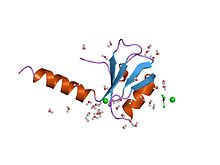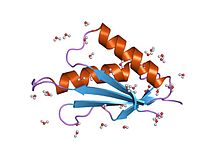In molecular biology, translation initiation factor IF-3 (gene infC) is one of the three factors required for the initiation of protein biosynthesis in bacteria. IF-3 is thought to function as a fidelity factor during the assembly of the ternary initiation complex which consists of the 30S ribosomal subunit, the initiator tRNA and the messenger RNA. IF-3 is a basic protein that binds to the 30S ribosomal subunit.[1] The chloroplast homolog enhances the poly(A,U,G)-dependent binding of the initiator tRNA to its ribosomal 30s subunits.[2] IF1–IF3 may also perform ribosome recycling.[3]
| Translation initiation factor IF-3, N-terminal domain | |||||||||
|---|---|---|---|---|---|---|---|---|---|
 translation initiation factor 3 n-terminal domain | |||||||||
| Identifiers | |||||||||
| Symbol | IF3_N | ||||||||
| Pfam | PF05198 | ||||||||
| InterPro | IPR019814 | ||||||||
| PROSITE | PDOC00723 | ||||||||
| SCOP2 | 1tif / SCOPe / SUPFAM | ||||||||
| |||||||||
| Translation initiation factor IF-3, C-terminal domain | |||||||||
|---|---|---|---|---|---|---|---|---|---|
 translation initiation factor 3 c-terminal domain | |||||||||
| Identifiers | |||||||||
| Symbol | IF3_C | ||||||||
| Pfam | PF00707 | ||||||||
| InterPro | IPR019815 | ||||||||
| PROSITE | PDOC00723 | ||||||||
| SCOP2 | 1tif / SCOPe / SUPFAM | ||||||||
| |||||||||
IF3 is not universally found in all bacterial species. However, in E. coli, it is required for the 30S subunit to bind to the initiation site in mRNA. In addition, it has several other jobs including the stabilization of free 30S subunits, enables 30S subunits to bind to mRNA and checks for accuracy against the first aminoacyl-tRNA. It also allows for rapid codon-anticodon pairing for the initiator tRNA to bind quickly. IF3 is required by the small subunit to form initiation complexes, but has to be released to allow the 50S subunit to bind.
IF3 is made up of two domains connected by a flexible linker. Together they allow IF3 to carry out its function.[4]
Human mitochondria use a nuclear-encoded homolog MTIF3 for translation initiation.[5] Some bacteria, chloroplasts, and mitochondria have multiple copies of IF3.[6]
References
edit- ^ Liveris D, Schwartz JJ, Geertman R, Schwartz I (September 1993). "Molecular cloning and sequencing of infC, the gene encoding translation initiation factor IF3, from four enterobacterial species". FEMS Microbiol. Lett. 112 (2): 211–6. doi:10.1111/j.1574-6968.1993.tb06450.x. PMID 8405963.
- ^ Lin Q, Ma L, Burkhart W, Spremulli LL (April 1994). "Isolation and characterization of cDNA clones for chloroplast translational initiation factor-3 from Euglena gracilis". J. Biol. Chem. 269 (13): 9436–44. doi:10.1016/S0021-9258(17)36900-4. PMID 8144528.
- ^ Pavlov, MY; Antoun, A; Lovmar, M; Ehrenberg, M (18 June 2008). "Complementary roles of initiation factor 1 and ribosome recycling factor in 70S ribosome splitting". The EMBO Journal. 27 (12): 1706–17. doi:10.1038/emboj.2008.99. PMC 2435134. PMID 18497739.
- ^ Hussain, T; Llácer, JL; Wimberly, BT; Kieft, JS; Ramakrishnan, V (22 September 2016). "Large-Scale Movements of IF3 and tRNA during Bacterial Translation Initiation". Cell. 167 (1): 133–144.e13. doi:10.1016/j.cell.2016.08.074. PMC 5037330. PMID 27662086.
- ^ D'Souza, AR; Minczuk, M (20 July 2018). "Mitochondrial transcription and translation: overview". Essays in Biochemistry. 62 (3): 309–320. doi:10.1042/EBC20170102. PMC 6056719. PMID 30030363.
- ^ Gutu, A.; Nesbit, A. D.; Alverson, A. J.; Palmer, J. D.; Kehoe, D. M. (18 September 2013). "Unique role for translation initiation factor 3 in the light color regulation of photosynthetic gene expression". Proceedings of the National Academy of Sciences. 110 (40): 16253–16258. Bibcode:2013PNAS..11016253G. doi:10.1073/pnas.1306332110. PMC 3791720. PMID 24048028.